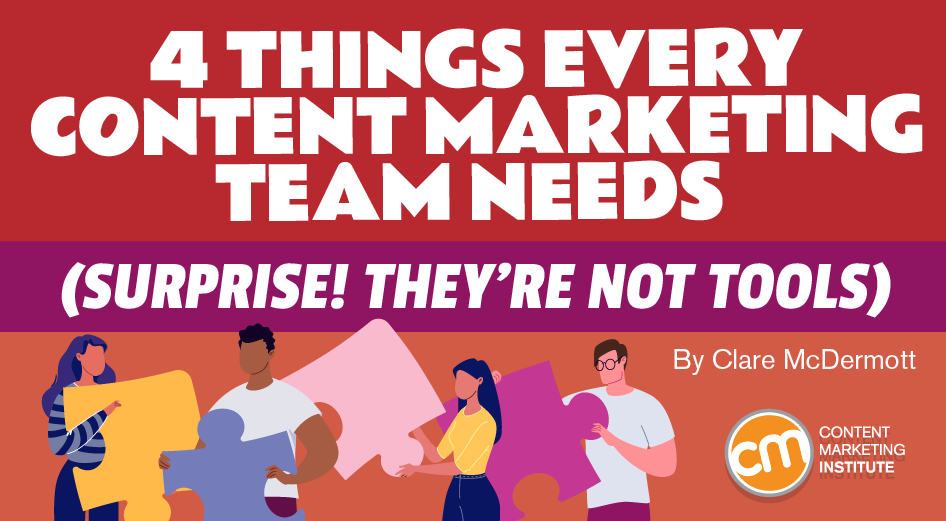
Updated February 15, 2022
It’s tempting to think technology can solve all our content marketing woes. And tech does play a role in making content marketers more productive and successful.
Too often, though, content leaders overlook underlying operational issues that technology alone can’t solve.
Focus on these four must-have systems, processes, and resources to get your content marketing engine working at top efficiency.
1. An editorial resource center
Think of your editorial resource center as a spot to document your so-called “Why?” Why do you create content? What are your goals? How do you operate in a way that’s disciplined and scalable?
The act of writing these things solidifies your vision and unites your team under a single purpose. And by making those documents easily accessible, you enable everyone involved in content to execute on that purpose with clarity.
Writing down your #content purpose and goals solidifies the vision and unites your team, says @clare_mcd via @CMIContent. Click To Tweet
Your resource center should include:
Your content marketing strategy
Successful content marketers are more likely to have a documented strategy, according to years of research from the Content Marketing Institute.
Your content marketing strategy document clearly explains key concepts such as audience, personas, buyer journey, and content goals. You may not refer to it daily or even weekly, but it’s there for team members to refer to when they need to refresh core concepts. It’s also a great onboarding resource for new hires. (Find good advice about how to document your strategy here.)
A content planning framework
A content framework is a cheat sheet for understanding which projects you should greenlight.
Back in 2016, Autodesk’s Dusty DiMercurio explained that his team uses the organizing mantra of head, heart, and hands for their content framework:
- Head describes future-looking thought leadership content written by executives.
- Heart encompasses inspiring stories from customers.
- Hands refers to content with a more practical bent.
Summarizing your content portfolio succinctly is particularly valuable when enlisting thought leaders and subject-matter experts to contribute to your content program.
A creative brief template
For some organizations, this template is supplied by their content development platform. But in most cases, creative briefs are homegrown documents created to outline the topical focus of the content piece and provide creators with pertinent details on its intended voice, style, format, and distribution channels.
An informative brief should include summary information about your company’s (or your client’s) mission, target audience, content purpose/goals, primary topic, keywords, and deadline.
(I know I said this article isn’t about tools, but this one’s too valuable not to share it here: I’m a big fan of Frase, a content creation tool that helps you optimize content as you write. The Frase toolkit includes an excellent creative brief-building template.)
An editorial guide
Which style guide should your writers rely on: AP, Chicago Manual of Style, or a custom one? What tone of voice and personality should your content emulate? An editorial guide helps writers understand the audience they’re writing for, special language considerations, and even preferred formatting and visuals.
An easy-to-find home
Finally, make sure all your content team resources reside in a single, easy-to-access place – or even better, indexed clearly on an intranet or collaboration platform your team uses regularly.
For example, at Cleveland Clinic, all these resources are gathered into a microsite called OnBrand. More than a brand style guide or press kit, OnBrand offers a wealth of information for both internal and external content creators – something that’s critical for an organization that publishes thousands of articles, videos, and guides about health topics. The site offers an overview of Cleveland Clinic’s history and mission, its pride points, digital assets, and detailed guides about design, writing, printing, and formatting for web and mobile.
HANDPICKED RELATED CONTENT:
2. A well-defined content ideation and review cycle
High-performing content teams always seem to have an abundance of valuable content ideas at the ready. It’s an enviable goal for all content marketers, but it doesn’t happen magically. It takes a sound process and ongoing optimization effort to pull off consistently.
Rachel Haberman knows a thing or two about content ideation. As the content marketing manager for Skyword for nearly two years, Rachel took a process-oriented approach to getting content from ideation to publication. (She’s now senior manager of content marketing at Ivanti.)
Following a process, Rachel says, ensures that your team has a steady flow of ideas informed by your audience insights and inspired by your business needs. Here’s the one she recommends:
- Identify collaborators. Figure out who inside your company has a direct connection to your customers and products and get their buy-in to participate in the process.
- Define tempo. Decide how to solicit and gather ideas from key stakeholders regularly. Rachel recommends a cadence of one-on-one calls to source new ideas.
- Winnow the list. Based on these calls/meetings, you’ll have a long list of inchoate topics. Narrowing that list involves appraising the potential value of each idea by asking questions such as: Is it a topic our audience cares about? What business initiatives does it support? Which actions will it drive?
- Refine ideas with your editorial team. Take your focused list and put it in front of the editorial team. These expert storytellers should wrestle with it, ensuring that the best ideas rise to the surface.
- Document your ideas in a creative brief. The creative brief development process fleshes out your ideas and provides the direction your content creators need to turn the ideas into impactful, shareable assets.
Though the content ideation and review cycle will depend on the specifics of your company’s program, including your publishing frequency, you must define one. “It sounds very basic, but having that discipline in place kept me sane and let us produce high quality at volume,” Rachel says.
To produce high quality at volume, define a #content ideation and review cycle, says #RachelHaberman of @GoIvanti via @CMIContent. Click To Tweet
HANDPICKED RELATED CONTENT:
ADVERTISEMENT
Definitive Guide to Content Operations
Get a deep dive into Content Operations: what it is, why it’s so important for organizations in every industry to embrace, what it’s capable of, and how you can build the best content operations solution for your teams. Download now.
3. Defined metrics
While most content marketers equate metrics with technology, it’s still important to step back from the laptop (no really, step back from your laptop) and define how – and how often – you plan to use performance data.
Consider these questions:
- Which metrics matter?
- How often do you need to view them?
- When should you apply the insights you receive from them?
The answers, of course, depend on your company goals, your publishing tempo, and your available resources.
Set a review and action schedule
Rachel says she aims to look at higher-level metrics, such as traffic and lead flow, every month. In addition, she consults the “in-the-weeds” data from Google Analytics at least weekly.
When Amanda Todorovich won Content Marketer of the Year for her work at Cleveland Clinic, she told CMI that her team even looks at some of their metrics daily to make sure important trends and opportunities don’t pass them by. “If something is trending and we need to react to it quickly, or if something has a lot of comments that might drive a follow-up story, we’re on it,” she said.
No matter what cadence you establish for monitoring your content’s performance, you need to determine when to act on new insights immediately and when it’s OK to wait and see if the data indicate an ongoing trend or just a one-off anomaly.
This often comes down to preference, team agility, and available team resources. Enterprise marketers might do well to adopt a formal process of analyzing and reviewing metrics data on a set schedule (e.g., during a monthly team meeting or timed to coincide with their organization’s quarterly performance reviews). Smaller or more agile teams might tweak certain content components (think headlines, keywords, or distribution channels) on a rolling basis to see how those shifts might move the needle.
Don’t forget to test
One technique all marketers should incorporate in their performance management process is the ability to conduct A/B tests, which can help home in on how specific variables might affect your audience’s engagement habits.
This one can be a bit challenging to manage without investing in tools. But it can be done manually on a small scale. Simply adjust one component of your content at a time (say, the format of your subject lines or the placement of your calls to action) and track whether it makes a noticeable impact on your key performance indicators (KPIs).
HANDPICKED RELATED CONTENT:
4. Team energy reserves
Lastly, let’s talk about work ethics and feeling overworked. If you don’t allow yourself and your team members to recharge mental batteries, you put both the quality of the work and marketing performance at risk.
If we don’t allow our teams to recharge their mental batteries, we are putting our #content quality and performance at risk, says @clare_mcd via @CMIContent. Click To Tweet
Content marketing systems need to include time to step back, look around, and find new supplies of inspiration and energy. This process is as critical as any other to enhance productivity.
How can content leaders make it happen? Here are some suggestions:
Schedule inspiring gatherings
Your team likely gets together regularly to solve specific business problems and source new ideas. But consider meeting less about the here and now and more about vision.
In a Medium article, Nathan Waterhouse, an innovation consultant who works with famed design firm IDEO, says scheduling the meeting well in advance is critical, as the idea is to ease your team’s stress by not forcing them to drop what they’re doing at a moment’s notice. And be sure your plans allow for flexible “detours.”
“If you’re just following a scripted agenda you’ll not be responding to tensions or opportunities that arise in the moment,” Nathan explains. He suggests creating a “parking lot” for questions and ideas. Then, address the questions and ideas at the end of each day.
Support clarity breaks
Sometimes even small changes can generate big gains. Leaders at PixelSpoke, a marketing and design firm, wanted to help their employees be more creative, so they adopted a practice called the “clarity break.” It’s modeled on Google’s 20% ethos but scaled to work for smaller companies.
Encourage vacations
Years ago, I worked for a company where the boss prized hard work and never took vacations. That made the rest of us feel awkward about asking for time off.
Yet we all know that sustained overwork leads to poor quality ideas. Content managers should lead by example by taking time to recharge. And if you notice that team members aren’t using vacations, encourage them to do so. Taking regular time off to recharge should be as important as delivering on metrics.
#Content managers should lead by example by taking time to recharge, says @clare_mcd via @CMIContent. Click To Tweet
Beyond content technology
Technology plays an essential role in the efficiency and performance of content marketing initiatives. But these tools don’t do the job alone. They work best when balanced by human insights, well-designed processes, and a commitment to content marketing team members.
HANDPICKED RELATED CONTENT:
All tools are suggested by the author. Feel free to include additional tools in the comments (from your company or ones that you have used).
This article originally appeared in CCO magazine.
Cover image by Joseph Kalinowski/Content Marketing Institute

![HubSpot's 2025 State of Blogging Report [Data from 500+ Marketers]](https://www.liveseo.com/wp-content/uploads/2025/02/HubSpots-2025-State-of-Blogging-Report-Data-from-500-Marketers.webp-300x300.webp)


